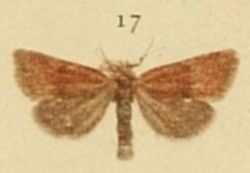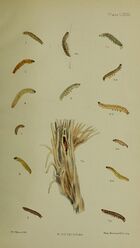Biology:Photedes captiuncula
| Photedes captiuncula | |
|---|---|

| |
| Scientific classification | |
| Domain: | Eukaryota |
| Kingdom: | Animalia |
| Phylum: | Arthropoda |
| Class: | Insecta |
| Order: | Lepidoptera |
| Superfamily: | Noctuoidea |
| Family: | Noctuidae |
| Genus: | Photedes |
| Species: | P. captiuncula
|
| Binomial name | |
| Photedes captiuncula (Treitschke, 1825)
| |
| Synonyms | |
| |
Photedes captiuncula, the least minor, is a moth of the family Noctuidae. It is found throughout Europe, in Turkey, Armenia, Russia and much of temperate Asia (western Siberia, Altai mountains, Central Asia and Amur).[1][2]
Technical description and variation
The wingspan is 15–18 mm.[2][3] Forewing whitish ochreous, the base and costal area fulvous, olive-tinged; the median and terminal areas either simply deeper fulvous or darkened with blackish scales; the lines white, thicker in female than male, sometimes diffusely expanded on inner margin; orbicular and reniform sometimes orange-tawny, or grey brown and obscure, generally with pale rings; hindwing dark fuscous; in expolita Dbld.the usual North British form, the forewing is uniform greyish brown; this is also recorded from Armenia; — in tincta Kane, from Ireland, (which Staudinger wrongly sinks to captiuncula), the basal area is grey, the median deep pink, and the terminal pale glossy pink.[4]
Biology
The moth flies in June and July.
Larva (of expolita) ochreous tinged with reddish, more purplish on the dorsum of middle segments; head reddish brown; thoracic plate paler. The larvae feed internally (in the stem and roots) on glaucous sedge, Carex glauca and other sedges.[3][5][6]
References
- ↑ Markku Savela. "Photedes captiuncula". funet.fi. http://www.nic.funet.fi/pub/sci/bio/life/insecta/lepidoptera/ditrysia/noctuoidea/noctuidae/xyleninae/photedes/index.html#captiuncula. Retrieved 6 January 2013.
- ↑ 2.0 2.1 Bert Gustafsson (10 November 2009). "Photedes captiuncula". Naturhistoriska riksmuseet. http://www2.nrm.se/en/svenska_fjarilar/p/photedes_captiuncula.html. Retrieved 6 January 2013.
- ↑ 3.0 3.1 Ian Kimber. "2344 Least Minor Photedes captiuncula". UKMoths. https://ukmoths.org.uk/show.php?id=1311. Retrieved 6 January 2013.
- ↑ Seitz, A. Ed., 1914 Die Großschmetterlinge der Erde, Verlag Alfred Kernen, Stuttgart Band 3: Abt. 1, Die Großschmetterlinge des palaearktischen Faunengebietes, Die palaearktischen eulenartigen Nachtfalter, 1914
- ↑ Wikisource:The Moths of the British Isles/Chapter 15#277
- ↑ "Robinson, G. S., P. R. Ackery, I. J. Kitching, G. W. Beccaloni & L. M. Hernández, 2010. HOSTS - A Database of the World's Lepidopteran Hostplants. Natural History Museum, London.". http://www.nhm.ac.uk/research-curation/research/projects/hostplants/.
External links
- Fauna Europaea
- Funet Taxonomy
- Lepiforum.de
Wikidata ☰ Q7187595 entry
 |


